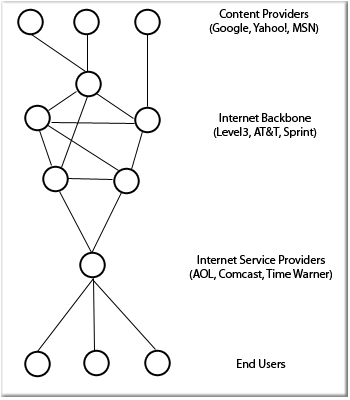The government’s role in regulating the internet has recently been a controversial issue recently. Many internet service providers are attempting to increase profits by charging content providers like Google and Yahoo! for broadcasting of their content to users. Content providers have supported Congressional proposals for a government-enacted ban on such charges while internet service providers insist it is a way to ensure availability of critical services and increase profits to allow for network improvements.
With recent internet success by companies like Google, eBay and the Facebook, internet service providers look to reap some of the success by exploiting power they have intrinsically on the network. Below is an example diagram of the structure of the internet. Note that end user’s must receive all of their data via their respective internet service provider. This gives service providers power over the content obtained by end users and, since content providers depend on visits by these end users to earn their massive profits, service providers are now looking to exploit their power in the network to increase profits as would be expected in any economic network.

Content providers insist that such taxes would be a detriment to the end user experience and suggests that the government enforce the ideal of Network Neutrailty, where no ISP can discriminate in the way traffic is handled based on content provider. Internet Service Providers, however, argue that these charges will allow for the institution of internet “fast lanes” that would allow critical content from heavily used content providers like Google and eBay would be delivered quickly and reliably to end users. Though congress has been reluctant to approve such a mandate as of yet, this will be an important issue to watch in the future.


* You can follow any responses to this entry through the RSS 2.0 feed.